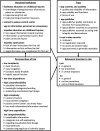Poisoning accidents in young children-Theory-based evaluation of an mHealth app
- PMID: 40777834
- PMCID: PMC12329195
- DOI: 10.1177/20552076251362753
Poisoning accidents in young children-Theory-based evaluation of an mHealth app
Abstract
Background: Unintentional childhood injuries such as poisonings are prevalent among young children and can have severe or even fatal consequences. As most of these injuries happen in and around the home, parents and other caregivers need to be prepared to prevent and deal with them. mHealth apps are promising for this, since regular smartphone use is widespread. This study evaluated the German app "Vergiftungsunfälle bei Kindern" (Poisoning Accidents in Children).
Methods: Parents (n = 21) and temporary caregivers (n = 21) of children under the age of seven were recruited for a mixed-methods study, comprising a remote usability test (thinking aloud, observation data and click protocols), focused interviews and the System Usability Scale (SUS).
Results: The mean usability score was 77.6 ± 15.7 out of 100. Most participants reported they trust the app and would use it in specific situations. The general app structure was perceived as clear. Perceived usefulness was facilitated by education on childhood injuries and contact to the poison control center, whereas it was impaired by the perception that the app impedes learning and rapid action in critical situations. Major obstacles included a reduced comprehensibility in terms of text design, visualizations, and complex language, all causing high time expenditure. Moreover, while some participants wished for condensed information, others expressed the need for more detailed explanations.
Conclusion: The results indicate that the intention to use the app was high, but its perceived ease of use and usefulness could be further enhanced by a better tailoring to different needs of caregivers.
Keywords: caregivers; digital health; evaluation; mHealth; mobile app; poisoning; usability.
© The Author(s) 2025.
Conflict of interest statement
The authors declared the following potential conflicts of interest with respect to the research, authorship, and/or publication of this article: Authors FB, JG, AM, PM, and AS are employed at the German Federal Institute for Risk Assessment, the publisher of the app Poisoning Accidents in Children. All other authors declare that there is no potential conflict of interest.
Figures



Similar articles
-
Tools for Evaluating the Content, Efficacy, and Usability of Mobile Health Apps According to the Consensus-Based Standards for the Selection of Health Measurement Instruments: Systematic Review.JMIR Mhealth Uhealth. 2021 Dec 1;9(12):e15433. doi: 10.2196/15433. JMIR Mhealth Uhealth. 2021. PMID: 34855618 Free PMC article.
-
A digital intervention to improve mental health and interpersonal resilience for young people who have experienced online sexual abuse: the i-Minds non-randomised feasibility clinical trial and nested qualitative study.Health Soc Care Deliv Res. 2025 Jul;13(28):1-27. doi: 10.3310/THAL8732. Health Soc Care Deliv Res. 2025. PMID: 40754856
-
Comparison of self-administered survey questionnaire responses collected using mobile apps versus other methods.Cochrane Database Syst Rev. 2015 Jul 27;2015(7):MR000042. doi: 10.1002/14651858.MR000042.pub2. Cochrane Database Syst Rev. 2015. PMID: 26212714 Free PMC article.
-
Sexual Harassment and Prevention Training.2024 Mar 29. In: StatPearls [Internet]. Treasure Island (FL): StatPearls Publishing; 2025 Jan–. 2024 Mar 29. In: StatPearls [Internet]. Treasure Island (FL): StatPearls Publishing; 2025 Jan–. PMID: 36508513 Free Books & Documents.
-
Home treatment for mental health problems: a systematic review.Health Technol Assess. 2001;5(15):1-139. doi: 10.3310/hta5150. Health Technol Assess. 2001. PMID: 11532236
References
-
- Peden M, Oyegbite K, Ozanne-Smith J, et al. World report on child injury prevention. World Health Organization, 2008. - PubMed
-
- Schwebel DC, Evans WD, Hoeffler SE, et al. Unintentional child poisoning risk: a review of causal factors and prevention studies. Child Health Care 2017; 46: 109–130.
LinkOut - more resources
Full Text Sources
Research Materials

